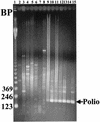A multiplex reverse transcription-PCR method for detection of human enteric viruses in groundwater
- PMID: 12788711
- PMCID: PMC161478
- DOI: 10.1128/AEM.69.6.3158-3164.2003
A multiplex reverse transcription-PCR method for detection of human enteric viruses in groundwater
Abstract
Untreated groundwater is responsible for about half of the waterborne disease outbreaks in the United States. Human enteric viruses are thought to be leading etiological agents of many of these outbreaks, but there is relatively little information on the types and levels of viruses found in groundwater. To address this problem, monthly samples from 29 groundwater sites were analyzed for 1 year for enteroviruses, hepatitis A virus, Norwalk virus, reoviruses, and rotaviruses by multiplex reverse transcription-PCR (RT-PCR). A procedure with which to remove environmental RT-PCR inhibitors from groundwater samples was developed. The procedure allowed an average of 71 liters of the original groundwater to be assayed per RT-PCR, with an average virus recovery rate of 74%, based on seeded samples. Human enteric viruses were detected in 16% of the groundwater samples analyzed, with reoviruses being the most frequently detected virus group.
Figures


Similar articles
-
Incidence of enteric viruses in groundwater from household wells in Wisconsin.Appl Environ Microbiol. 2003 Feb;69(2):1172-80. doi: 10.1128/AEM.69.2.1172-1180.2003. Appl Environ Microbiol. 2003. PMID: 12571044 Free PMC article.
-
Detection of enteroviruses, hepatitis A virus and rotaviruses in sewage by means of an immunomagnetic capture reverse transcription-PCR assay.Microbiol Res. 2002;157(3):169-75. doi: 10.1078/0944-5013-00152. Microbiol Res. 2002. PMID: 12398285
-
Vulnerability of drinking-water wells in La Crosse, Wisconsin, to enteric-virus contamination from surface water contributions.Appl Environ Microbiol. 2004 Oct;70(10):5937-46. doi: 10.1128/AEM.70.10.5937-5946.2004. Appl Environ Microbiol. 2004. PMID: 15466536 Free PMC article.
-
Rethinking the Significance of Reovirus in Water and Wastewater.Food Environ Virol. 2016 Sep;8(3):161-73. doi: 10.1007/s12560-016-9250-8. Epub 2016 Jun 18. Food Environ Virol. 2016. PMID: 27318494 Free PMC article. Review.
-
Polymer monoliths for the concentration of viruses from environmental waters: A review.J Sep Sci. 2022 Jan;45(1):134-148. doi: 10.1002/jssc.202100282. Epub 2021 Jun 26. J Sep Sci. 2022. PMID: 34128332 Review.
Cited by
-
Development and evaluation of reverse transcription-loop-mediated isothermal amplification assay for rapid detection of enterovirus 71.BMC Infect Dis. 2011 Jul 18;11:197. doi: 10.1186/1471-2334-11-197. BMC Infect Dis. 2011. PMID: 21767352 Free PMC article.
-
EPA Method 1615. Measurement of Enterovirus and Norovirus Occurrence in Water by Culture and RT-qPCR. Part III. Virus Detection by RT-qPCR.J Vis Exp. 2016 Jan 16;(107):e52646. doi: 10.3791/52646. J Vis Exp. 2016. PMID: 26862985 Free PMC article.
-
Indirect effects of COVID-19 on the environment: How deep and how long?Sci Total Environ. 2022 Mar 1;810:152255. doi: 10.1016/j.scitotenv.2021.152255. Epub 2021 Dec 10. Sci Total Environ. 2022. PMID: 34896489 Free PMC article.
-
New electropositive filter for concentrating enteroviruses and noroviruses from large volumes of water.Appl Environ Microbiol. 2009 Apr;75(8):2393-9. doi: 10.1128/AEM.00922-08. Epub 2009 Feb 13. Appl Environ Microbiol. 2009. PMID: 19218410 Free PMC article.
-
Presence of noroviruses and other enteric viruses in sewage and surface waters in The Netherlands.Appl Environ Microbiol. 2005 Mar;71(3):1453-61. doi: 10.1128/AEM.71.3.1453-1461.2005. Appl Environ Microbiol. 2005. PMID: 15746348 Free PMC article.
References
-
- Beller, M., A. Ellis, S. H. Lee, M. A. Drebot, S. A. Jenkerson, E. Funk, M. D. Sobsey, O. D. Simmons III, S. S. Monroe, T. Ando, J. Noel, M. Petric, J. P. Middaugh, and J. S. Spika. 1997. Outbreak of viral gastroenteritis due to a contaminated well: international consequences. JAMA 278:563-568. - PubMed
-
- Centers for Disease Control. 1983. Water-related disease surveillance annual summary 1982. HHS publication no. (CDC)83-8385. Centers for Disease Control, Atlanta, Ga.
-
- Craun, G. F. 1990. Review of the causes of waterborne outbreaks, p. 1-22. In G. F. Craun (ed.), Methods for the investigation and prevention of waterborne disease outbreaks. EPA/600/1-90/005a. U.S. Environmental Protection Agency, Cincinnati, Ohio.
Publication types
MeSH terms
LinkOut - more resources
Full Text Sources
Other Literature Sources

